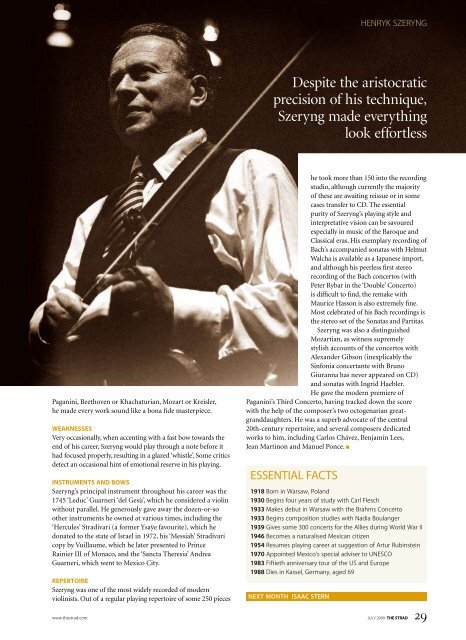You also want an ePaper? Increase the reach of your titles
YUMPU automatically turns print PDFs into web optimized ePapers that Google loves.
Paganini, Beethoven or Khachaturian, Mozart or Kreisler,<br />
he made every work sound like a bona fide masterpiece.<br />
Weaknesses<br />
very occasionally, when accenting with a fast bow towards the<br />
end of his career, <strong>Szeryng</strong> would play through a note before it<br />
had focused properly, resulting in a glazed ‘whistle’. Some critics<br />
detect an occasional hint of emotional reserve in his playing.<br />
insTrumenTs and boWs<br />
<strong>Szeryng</strong>’s principal instrument throughout his career was the<br />
1745 ‘Leduc’ Guarneri ‘del Gesù’, which he considered a violin<br />
without parallel. He generously gave away the dozen-or-so<br />
other instruments he owned at various times, including the<br />
‘Hercules’ Stradivari (a former Ysaÿe favourite), which he<br />
donated to the state of Israel in 1972, his ‘Messiah’ Stradivari<br />
copy by vuillaume, which he later presented to Prince<br />
Rainier III of Monaco, and the ‘Sancta Theresia’ Andrea<br />
Guarneri, which went to Mexico City.<br />
reperToire<br />
<strong>Szeryng</strong> was one of the most widely recorded of modern<br />
violinists. Out of a regular playing repertoire of some 250 pieces<br />
www.thestrad.com<br />
Despite the aristocratic<br />
precision of his technique,<br />
<strong>Szeryng</strong> made everything<br />
look effortless<br />
he took more than 150 into the recording<br />
studio, although currently the majority<br />
of these are awaiting reissue or in some<br />
cases transfer to CD. The essential<br />
purity of <strong>Szeryng</strong>’s playing style and<br />
interpretative vision can be savoured<br />
especially in music of the Baroque and<br />
Classical eras. His exemplary recording of<br />
Bach’s accompanied sonatas with Helmut<br />
Walcha is available as a Japanese import,<br />
and although his peerless first stereo<br />
recording of the Bach concertos (with<br />
Peter Rybar in the ‘Double’ Concerto)<br />
is difficult to find, the remake with<br />
Maurice Hasson is also extremely fine.<br />
Most celebrated of his Bach recordings is<br />
the stereo set of the Sonatas and Partitas.<br />
<strong>Szeryng</strong> was also a distinguished<br />
Mozartian, as witness supremely<br />
stylish accounts of the concertos with<br />
Alexander Gibson (inexplicably the<br />
Sinfonia concertante with Bruno<br />
Giuranna has never appeared on CD)<br />
and sonatas with Ingrid Haebler.<br />
He gave the modern premiere of<br />
Paganini’s Third Concerto, having tracked down the score<br />
with the help of the composer’s two octogenarian greatgranddaughters.<br />
He was a superb advocate of the central<br />
20th-century repertoire, and several composers dedicated<br />
works to him, including Carlos Chávez, Benjamin Lees,<br />
Jean Martinon and Manuel Ponce.<br />
EssEntial Facts<br />
1918 Born in Warsaw, Poland<br />
1930 Begins four years of study with Carl Flesch<br />
1933 Makes debut in Warsaw with the Brahms Concerto<br />
1933 Begins composition studies with nadia Boulanger<br />
1939 gives some 300 concerts for the Allies during World War II<br />
1946 Becomes a naturalised Mexican citizen<br />
1954 resumes playing career at suggestion of Artur rubinstein<br />
1970 Appointed Mexico’s special adviser to UnesCO<br />
1983 Fiftieth anniversary tour of the Us and europe<br />
1988 Dies in kassel, germany, aged 69<br />
nexT monTh ISaac Stern<br />
HenrYk szerYng<br />
JULY 2009 The sTrad 29


